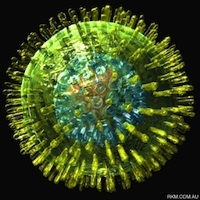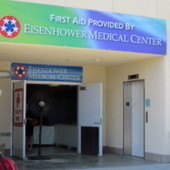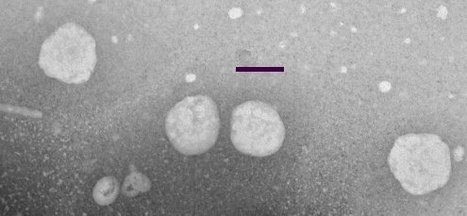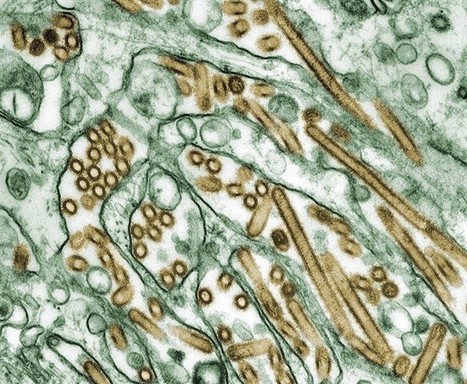 Your new post is loading...
 Your new post is loading...

|
Scooped by
Ed Rybicki
March 13, 2012 4:45 AM
|
The key finding of the Blackman study is that the mechanism by which a type of white blood cell, called a CD8 T cell, controls the virus differs between the initial active phase of infection and long-term latent infection. These novel findings will accelerate efforts to develop therapies to control gamma-herpesvirus infections and prevent the development of virus-associated cancers. Image from Russell Kightley Media

|
Scooped by
Ed Rybicki
March 13, 2012 4:14 AM
|
Scientists who have mutated an airborne version of the killer bird flu virus H5N1 say it's essential their research be published in order to find a cure, but opponents say this would produce a 'how to' manual for terrorists. Nice set of interviews and balanced account - with Vincent Racaniello, Laurie Garrett, and Ron Fouchier Image from Russell Kightley Media

|
Scooped by
Ed Rybicki
March 13, 2012 3:59 AM
|
A nasty virus with symptoms of nausea and vomiting spread quickly through the BNP Paribas Open tennis tournament this weekend, sickening at least six players and many fans. The virus -- which has been reported outside the tournament gates throughout the Coachella Valley -- results in symptoms of nausea and vomiting, fever, and subsequent diarrhea, according to a statement released by Eisenhower Medical Center. I can see players not wanting handle balls someone else has touched...quite catching, are noroviruses!

|
Scooped by
Ed Rybicki
March 13, 2012 3:57 AM
|
Human infections with H5N1 avian influenza reported in Indonesia and VietnamExaminer.comAlso on Monday, a GAR was issued concerning an avian influenza case in Vietnam.

|
Scooped by
Ed Rybicki
March 13, 2012 3:55 AM
|
Media release from University of SydneyYou might have heard of warming up for a football match, butresearchers from the University of Sydney are hoping that warmingup for a flu vaccine could imprve its effectiveness and reduce illness and death in the elderly. Whatever next - yoga before HPV?

|
Scooped by
Ed Rybicki
March 12, 2012 11:56 AM
|

|
Scooped by
Ed Rybicki
March 12, 2012 6:31 AM
|
HIV-positive youngsters who were infected before or at birth reveal their secret lives... "A recent survey by the National Aids Trust found that one in five adults do not realise the disease can be transmitted through sex without a condom. Fewer than half believe it can be passed by sharing needles or syringes. Around 10% believe it can be transmitted through kissing and spitting – an increase of 100% since 2007. The stigma that society places on HIV has another, even nastier knock-on effect: it means that children cannot be told of their diagnosis until they are judged to be able to keep it confidential. The consequence of this is that unlike other childhood diseases, children born with HIV often learn of their diagnosis after they have already absorbed the fear and believed the lies about the disease that swill around society. The trauma can be deep and long-lasting." The pandemic is 30-odd years old, and still rolling - and we have millions of people to look after, who will be with us for many years - thanks to ARVs and HAART. In South Africa, ARV provision is rapidly becoming the single biggest health expense. We need some other interventions NOW.

|
Scooped by
Ed Rybicki
March 12, 2012 6:21 AM
|
Hypothetically, since native HIV-1 Env trimers are exclusively recognized by neutralizing antibodies, they might induce the neutralizing antibodies in a vaccine setting. This idea has not been evaluated due to the difficulty of separating trimers from nonfunctional Env (uncleaved gp160 and gp41 stumps). The latter are immunodominant and induce nonneutralizing antibodies. We previously showed that nonfunctional Env can be selectively cleared from virus-like particle (VLP) surfaces by enzyme digests (E. T. Crooks, T. Tong, K. Osawa, and J. M. Binley, J.Virol. 85:5825, 2011). Here, we investigated the effects of these digests on the antigenicity of VLPs and their sensitivity to neutralization. I'm a fan of HIV VLPs - an under-appreciated vaccine candidate! Image courtesy of Ann Meyers, plant-made HIVC Pr55Gag VLPs, our lab collection

|
Scooped by
Ed Rybicki
March 10, 2012 11:15 AM
|
This video says about itself: Since an infectious salmon virus emerged two years ago, salmon production in this small Chilean port has seen a loss of six thousand jobs. The virus known as ISA, is l... The aetiological agent of ISA is the infectious salmon anemia virus (ISAV). ISAV, a RNA virus, is the only species in the genus "Isavirus"... http://viralzone.expasy.org/all_by_species/95.html ;

|
Scooped by
Ed Rybicki
March 10, 2012 10:59 AM
|
Bird flu has hit six poultry markets in the capital. In the last 15 days, three workers from one of the markets came down with the flu; however, they have recovered.The Institute of Epidemiology, Disease Control and Research (IEDCR) and International Centre for Diarrhoeal Disease Research, Bangladesh (ICDDR, B) made the detections.The affected markets are among the 16 poultry markets that are under constant surveillance by the two research organisations, IEDCR sources say.In the wake of the latest developments, the Department of Livestock Services at a meeting on Wednesday decided to form 10 committees to monitor all poultry markets in the capital... And people want to make folk in Canada and the USA work in BSL4 environments on this virus? Please!

|
Scooped by
Ed Rybicki
March 10, 2012 10:57 AM
|
Via Saigon Giai Phong: Ministry warns of bird flu pandemic in Vietnam. Nguyen Van Binh, Head of the Department of Preventive Health under the Ministry of Health, stated on March 9 that Vietnam had recorded four cases of ...

|
Scooped by
Ed Rybicki
March 10, 2012 10:41 AM
|
In October and November 2010, novel H1N2 reassortant influenza viruses were identified from pigs showing mild respiratory signs that included cough and depression. Sequence and phylogenetic analysis showed that the novel H1N2 reassortants possesses HA and NA genes derived from recent H1N2 swine isolates similar to those isolated from Midwest. Compared to the majority of reported reassortants, both viruses preserved human-like host restrictive and putative antigenic sites in their HA and NA genes. The four internal genes, PB2, PB1, PA, and NS were similar to the contemporary swine triple reassortant viruses' internal genes (TRIG). Interestingly, NP and M genes of the novel reassortants were derived from the 2009 pandemic H1N1. Depressed pigs? Do they sigh a lot and watch weepy movies? But that H1N1 is a real survivor - its genes or some of them have persisted since 1918, and don't look to be going away.

|
Scooped by
Ed Rybicki
March 10, 2012 10:32 AM
|
Transmissible spongiform encephalopathy (TSE) diseases are known to be zoonotic diseases that can infect different kinds of animals. Conclusions This finding concludes that mouse-adapted agents 139A and ME7 change their pathogenic characteristics during the transmission to hamsters. The novel prions in hamsters' brains obtain new molecular properties with hamster-specificity. No more mouse kebabs, people.... Seriously, though, this is rather sinister in terms of expanding the known "phylogenetic gap" that prions can cross
|

|
Scooped by
Ed Rybicki
March 13, 2012 4:43 AM
|
GeoVax Labs, Inc. (otcqb/otcbb:GOVX), an Atlanta – based biopharmaceutical firm developing vaccines to prevent and fight Human Immunodeficiency Virus (HIV) infections, announced receipt of an “Allowed to Proceed” notice from the U.S. Food and Drug Administration (FDA) for human clinical testing of its granulocyte-macrophage colony stimulating factor (GM-CSF) -adjuvanted DNA/MVA vaccine. The Phase 1 trial is being sponsored by the National Institute of Allergy and Infectious Diseases (NIAID), part of the National Institutes of Health, and will be conducted by the NIAID-funded HIV Vaccine Trials Network (HVTN) under protocol HVTN 094. And they tell you all that, then don't actually say what the vaccine is.

|
Scooped by
Ed Rybicki
March 13, 2012 4:03 AM
|
With Hand, Foot and Mouth Disease (HFMD) hitting epidemic levels here, a vaccine against the virulent EV71 strain of the disease took a step closer to the market on Monday. The INV21 vaccine could be the world's first - provided its developer Inviragen pips pharmaceutical companies in other parts of the world in rolling out a vaccine against a disease that Asian countries are increasingly grappling with. As part of its first phase trial - done in collaboration with the National University Health System and Duke-NUS Graduate Medical School - the INV21 vaccine induced immune responses among all trial participants. The clinical trial results of the INV21 vaccine are "very promising", said principal investigator Dr Paul Tambyah of the National University Hospital. "We look forward to continued collaboration on HFMD research and carrying out large-scale trials in partnership with Inviragen, to bring successful vaccine candidates such as INV21 closer to clinical use, to help protect vulnerable children in this part of the world." The vaccine could be available in the market in 2015, Inviragen's chief operating officer Joseph Santangelo told Today.

|
Scooped by
Ed Rybicki
March 13, 2012 3:58 AM
|
In a new twist in the ongoing controversy over publication of two studies involving H5N1 viruses with increased transmissibility, there are indications that the Dutch government may consider using export regulations to prevent full publication of the study by Ron Fouchier, PhD, and colleagues. In a Mar 7 letter to the Dutch parliament, the country's minister of public health, welfare, and sport, Dr. E. I. Schippers, said an export permit is required for dissemination of detailed information about the H5N1 virus outside the European Union. If such a permit is requested, the government will consider the health and safety risks of granting it, the minister said. In addition, a Mar 9 report in a Dutch newspaper, the Amsterdam-based Volkskrant, said that Henk Bleker, the nation's secretary for agriculture and foreign trade, thinks that the government could prevent publication of the virus "recipe" by denying an export license. Deities preserve us from stupid people....

|
Scooped by
Ed Rybicki
March 13, 2012 3:56 AM
|
Independent OnlineWorld watches as NZ starts flu campaignVoxyNew Zealand's national free influenza immunisation campaign was officially launched in Wellington today by the National Influenza Specialist Group (NISG) 1. You know, some 500 000 people die EVERY YEAR of flu, around the world - and we HAVE vaccines; they're just made in a primitive way and cost quite a lot. It's really time that changed.

|
Scooped by
Ed Rybicki
March 13, 2012 3:51 AM
|
Bird Flu Outbreaks in Israel Kill 10500 Turkeys, Officials SayBusinessWeekBy Jason Gale on March 12, 2012 Bird flu killed about 10500 turkeys on two farms in western Israel, the first outbreaks of the deadly H5N1 strain in the country in 11 months,...

|
Scooped by
Ed Rybicki
March 12, 2012 10:41 AM
|
Using full-length sequences of all known alphaviruses, we produced a robust and comprehensive phylogeny of the Alphavirus genus, presenting a more complete evolutionary history of these viruses compared to previous studies based on partial sequences. Our phylogeny suggests the origin of the alphaviruses occurred in the southern oceans and spread equally through the Old and New World. Since lice appear to be involved in aquatic alphavirus transmission, it is possible that we are missing a louse-borne branch of the alphaviruses. Of course, I think ALL viruses came out of the water - some longer ago than others. Always thought that was a lousy branch of virology...thanks Stephen Korsman!

|
Scooped by
Ed Rybicki
March 12, 2012 6:26 AM
|
Respiratory syncytial virus, better known as RSV, is a very common illness among babies during the winter and spring. This virus causes an infection of a baby’s respiratory tract and can cause a range of symptoms. Your baby might refuse feedings, breathe quickly, run a fever, and have a lot of mucous in the nose and mouth. There is no cure for RSV, but parents can treat their baby’s symptoms at home for most mild cases.

|
Scooped by
Ed Rybicki
March 10, 2012 11:22 AM
|
Might some forms of neurological illness be caused at least partly by infectious agents? Might some forms of neurological illness, such as multiple sclerosis and schizophrenia, be caused at least partly by bacteria, viruses or other parasites? A largely Danish team has recently published evidence of a strong association between multiple sclerosis and a retrovirus, together with hints that a gene called TRIM5, which is used by cells to fight viruses, is especially active in people with MS.

|
Scooped by
Ed Rybicki
March 10, 2012 11:01 AM
|
OKLAHOMA CITY --...Respiratory Syncytial Virus, better known as RSV, is spreading across the state, with 49 reports of the virus in the past week. Since February, over 200 cases have been reporter at OU Medical Center.Doctors say it is the most common reason for an infant to be hospitalized. Director of Infectious Diseases at OU Children’s Hospital, Dr. Robert Welliver, said, “They’ll have a lot of trouble breathing, they’ll start wheezing, the cough really increases and you’ll hear raspy sounds coming from their chest.” The OTHER respiratory virus is biting....

|
Scooped by
Ed Rybicki
March 10, 2012 10:57 AM
|
Scientists fear row over bird flu studies may undermine credibility of the fieldWinnipeg Free PressTORONTO - As influenza scientists and biosecurity experts continue to do battle over controversial bird flu studies, some in the flu world worry arguments...

|
Scooped by
Ed Rybicki
March 10, 2012 10:44 AM
|
Warning: bullsh1t alert "Vaccines are based on a scientific-sounding mythology that is widely believed by gullible physicians and scientists who simply believe what they are told rather than what’s real. This mythology is based on the belief that injecting foreign matter into the human body will cause the immune system to adapt to the weakened foreign matter by creating antibodies that fight off future infections. This explanation, however, is pure mythology. In reality, an immune system can only invoke an adaptive response when it is properly nourished with vitamin D. And if the patient has enough vitamin D, they need no vaccine because vitamin D protects them from seasonal influenza in the first place." Yeah. Right. SO people in sunny countries don't get flu? Rubbish!!! If anything, flu is worse in the tropics because it occurs all year round!

|
Scooped by
Ed Rybicki
March 10, 2012 10:37 AM
|
DNR warns of largemouth bass virus in 4 West Virginia lakesThe RepublicThe Division of Natural Resources say recent samples of fish have revealed the presence of largemouth bass virus in four West Virginia lakes. Whatever next? Gibson long neck virus...Fender Stratocaster wilt....
|



 Your new post is loading...
Your new post is loading...




















